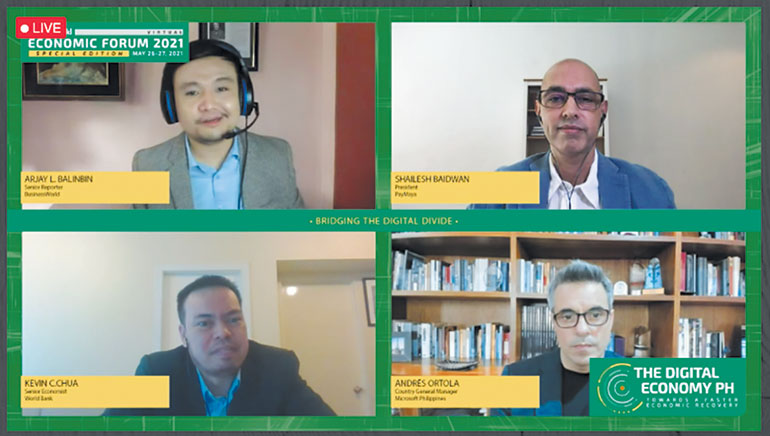Bridging the digital divide in the Philippines

By Adrian Paul B. Conoza, Special Features Writer
As the push towards a digital economy gets accelerated, with the increased use of and preference for digital tools due to the COVID-19 pandemic, several related issues cannot be overlooked. Among them is the “digital divide” which simply indicates the lack of equity in access to digital tools such as the Internet and digital-enabled services such as electronic payments and online learning.
The Philippines Digital Economy Report 2020 of the National Economic Development Authority and the World Bank highlighted that the Philippines still experiences “a very significant digital divide”, with more than half of total households in the country lacking Internet access and fixed and mobile Internet penetration in the Philippines faring relatively low, compared to its Southeast Asian neighbors. This divide is seen to contribute to unequal access to services that are delivered via the Internet.
During a panel discussion in the BusinessWorld Virtual Economic Forum 2021 Special Edition, two heads from leading digital companies and an economist recognized the need to address this divide, while sharing their thoughts on how it can be done.
Sharing from the digital payments perspective, Shailesh Baidwan, president of PayMaya Philippines, noted that the advent of digital economy allows nearly everyone to participate in the formal economy. He also observed that as the push for digital payments is now taking a ‘natural momentum’ — with various sectors of society further appreciating digital payments — the opportunity opens to include more Filipinos into the financial system.
“For fintechs like us working with the government, the regulators, and other players in the industry, I think this is an opportunity to narrow and break the [digital] divide with financial solutions; and to bring the unbanked, the underserved, and what I call the unhappily served into the formal system,” Mr. Baidwan said.
The PayMaya executive pointed out three priorities in bridging the digital divide, namely bridging online and offline and vice versa; moving at an accelerated pace to include the unbanked sectors; and working on a bigger and deeper digital talent pool.
“The solutions need to be built on automated and digital platforms that can serve large volumes. [We should also] provide sachet-sized financial services in a cost-effective way,” Mr. Baidwan said about including the unbanked.
Giving insights from a broader perspective, Kevin C. Chua, senior economist at World Bank, highlighted several barriers that are causing the digital divide. These include gaps in material access, pertaining to gadgets and network connection; gaps in skills access, referring to digital literacy and competency; gaps in usage access, having to do with the systematic use of programs, applications, content, and services; and gaps in motivational access, which refers to the trust and confidence in using technologies.
Mr. Chua further noted that there are two determinants driving the digital divide. In terms of access, income becomes the determining factor, with well-off consumers more able to afford gadgets and connectivity. In terms of digital skills, age generates the gap, with the younger population being more tech-savvy and receptive to change.
The senior economist added that while there are indications that the digital divide may be narrowing in the Philippines, including surge in the number of Internet and digital payments users, much work remains to be done. “There’s a lot of catching up [which] will require addressing these barriers to material, skills, usage, and motivational access,” he said.
 Mr. Chua recommends that devices, gadgets, and connections should be made more available and affordable by mobilizing the private sector and encouraging competition.
Mr. Chua recommends that devices, gadgets, and connections should be made more available and affordable by mobilizing the private sector and encouraging competition.
He also stressed the need to support the young and working-age population through education and digital skills training. “We need to encourage the young people to move beyond entertainment, gaming, and communication, into [learning] more advanced tasks, and education would be key to that,” he added.
Mr. Chua also finds it important to address the gaps in motivational access by building trust and confidence in the use of technology. “This involves strengthening cybersecurity measures, data privacy, and data protection ecosystem,” he said. “In e-commerce, we should set up a regulatory framework to protect both sellers and buyers from fraud and unscrupulous practices.”
Going deeper into other aspects of addressing the digital divide, Andrés Ortola, country general manager of Microsoft Philippines, noted the value of activating partnerships and collaborations especially in education, with many students struggling to access quality online learning.
“We must continue building coalitions, partnerships, and initiatives to tackle this digital divide,” he said, adding that public and private institutions coming together to tackle societal problems is needed to create new economies.
Mr. Ortola further stressed that the future of a digital society must be built in the pillars of trust, inclusion, growth, and security. “It’s our responsibility as leaders to ensure inclusive access, leverage technology to reach millions of people, and empower them with the necessary skills to thrive in the digital era,” he added.
He also said that while many technologies are already available, the greater challenge is driving innovation in a more pervasive way.
Among these technologies, the Microsoft executive noted the potential of cloud infrastructure to allow solutions to be deployed faster, more securely, and more broadly. “The Philippines is an ideal country for cloud,” he said. “Cloud would bring this level of resiliency and service that everybody needs.”



